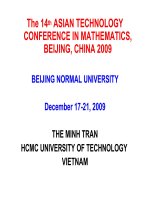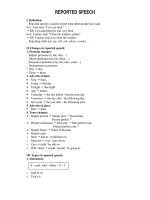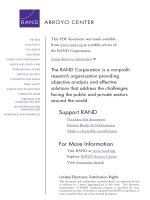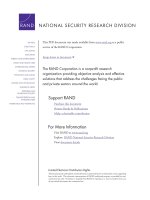Report ex2
Bạn đang xem bản rút gọn của tài liệu. Xem và tải ngay bản đầy đủ của tài liệu tại đây (80.95 KB, 7 trang )
Pre Lab Questions:
Experiment 2
Experiment 2: Prelaboratory Assignment.
1. Experiment Procedure,Part A.
a. What is the criterion for clean glassware?
- The absence of any lingering substances that can potentially have an
impact on the experiment's outcome qualifies as clean glassware. They
must be completely cleaned and disinfected.
b. What is the size and volume of a “small, clean test tube”?
- The size of a small, clean test tube is 75mm. The volume of a small
and cleantest tube is 3mL.
2. Exiperiment Procedure, Part A.2. Describe the technique for
testing the odor of a chemical.
-The technique for testing the odor of a chemical is wafting. To
explain, you must place your hand above the test tube and in a
circular motion, in the direction of your face, and nose, motion the
movement and the wave of your hands to direct the air in the direction
towards your face.
3. Identify at least five observations that are indicative of a chemical
reaction.
- At least five observations that are indicative of a chemical reaction,
are the gas evolves, theprecipitate appears or disappears, the heat is
given off or absorbed, there is a noticeablechange in color and finally,
there is a noticeable odor.
4. Experimetal Procedure, Part A.1. Referring to Appendix G for the
substances listed here; underline those that are soluble and circle those
that are insoluble:
AgNO3: underline
NaCl: underline
AgCl: circle
Na2CO3: underline
Ag2CO3: circle
MgSO4 :underline
Ag2SO4: underline
NH4CL: underline
5. Experimental Procedure, Part A. The substances NaCl, Na₂CO₃, CO₃, ,
MgSo , and NH Cl, which are used for test solutions, are all soluble
ionic compounds. For each substance, indicate the ions present in its
respective test solution.
NaCl: Na⁺Cl⁻Cl⁻
Na₂CO₃, CO₃, : CO₃, ²⁻
MgSo :Mg²⁺Cl⁻SO ²⁻
NH Cl:NH ⁺Cl⁻Cl⁻
6. Three colorless solutions in test tubes, with no labels, are in a test tube
rack on the laboratory bench. Lying beside the test tubes are three labels:
potassium iodide, KI; silver nitrate, AgNO₃, ; and sodium sulfide, Na₂CO₃, S.
You are to place the labels on the test tubes using only the three
solutions present. Here are your tests:
A portion of test tube 1 added to a portion of test tube 3 produces a
yellow
A portion of test tube 1 added to a portion of test tube 3 produces a
yellow silver iodide precipitate.
●
A portion of test tube 1 added to a portion of test tube 2 produces
a black
A portion of test tube 1 added to a portion of test tube 2 produces silver
sulfide precipitate.
●
A portion of test tube 1 added to a portion of test tube 3 produces
a yellowsilver iodide precipitate.
●
A portion of test tube 1 added to a portion of test tube 2 produces
a black
a. Your conclusions are:
Test tube 1:silver nitrate
Test tube 2:sodium sulfide
Test tube 3: potassium iodide
b. Write a balanced equation for the formation of silver iodide, AgI,
from a mix of two selected solutions provided above.
X + Y → AgI
AgNO₃, +KI→AgI+KNO₃,
c. Write the balanced equation for the formation of silver sulfide, Ag₂CO₃, S,
from a mix of two selected solutions provided above.
X + Y→Ag₂CO₃, S
AgNO₃, +NA₂CO₃, S→Ag₂CO₃, S+ NaNO₃, (unbalanced)
2AgNO₃, +NA₂CO₃, S→Ag₂CO₃, S+ 2NaNO₃, (balanced)
Laboratory Questions
1. Identify a chemical reagent used in this experiment that can be
used to distinguish solid CaCl2 (soluble) from solid CaCO3
(insoluble). What is the distinguishing observation?
- The chemical reagent used in this experiment that would
distinguish CaCl2 (soluble) from CaCO3 (insoluble) would be Hal.
If HCl is added, then the compound CaCO3 (insoluble) will fix.
On the other hand, the compound CaCl2 (soluble) will not fix. So
the distinguishing observation would be fizzing which indicates the
creation of a gas.
2. What test reagent used in this experiment will distinguish a soluble
Cl- salt from a soluble SO42– salt? What is the distinguishing
observation?
- The test reagent that was used in this experiment that will
distinguish a soluble Cl- salt from a soluble SO42– salt, is silver
nitrate. To explain, silver nitrate can be used to distinguish
between the two. The distinguishable observation is that Cl- salt
will form a white precipitate and will SO42– form clear crystals.
3. Predict what would be observed (and why) from an aqueous
mixture for each of the following (all substances are water soluble).
a. potassium carbonate and hydrochloric acid
- It would produce a carbon dioxide gas leaving behind aqueous
potassium chloride.
b. zinc chloride and silver nitrate
-It would produce a white precipitate of silver chloride.
c. magnesium chloride and sodium hydroxide
- It would produce a white precipitate if magnesium hydroxide since
most hydroxides are insoluble.
d. ammonium nitrate and sodium hydroxide
- It would produce ammonia gas with an odor
4. Three colorless solutions in test tubes, with no labels, are in a test
tube rack on the laboratory bench. Lying beside the test tubes are
three labels: silver nitrate, AgNO3; hydrochloric acid, HCL; and
sodium carbonate, Na2CO3. You are to place the labels on the test
tubes using only the three solutions present. Here is your analysis
procedure:
• A portion of test tube 1 added to a portion of test tube 2 produces
CO2.
• A portion of test tube 2 added to a portion of test tube 3 produces
a white silver carbonate precipitate.
a. On the basis of your observations, how would you label the
three test tubes?
Test tube 1: HCl
Test tube 2: Na2CO3
Test tube 3: AgNO3
b. What would you expect to happen if a portion of test tube 1 is
added to a portion of test tube 3?
- If a portion of test tube 1 is added to portion of test tube 3, we
would get a AgCl and acid HNO3. Because AgCl is slightly
soluble, this experiment will have a precipiate.
5. For individual solutions of the cations Ag+ , Ba2+ , Mg2+, and Cu2+ the
following experimental observations were collected
Ag+
Ba2+
NH3
No change
No change
HCl
White ppta
No change
H2SO4
No change
White ppt
Mg2+
Cu2+
White ppt
No change
No change
Blue ppt/deep No change
No change
blue soln with
excess
From these experimental observations,
a. Identify a reagent that distinguishes the chemical properties of Ag+
and Mg2+. What is the distinguishing observation?
- A reagent that distinguishes the chemical properties of Ag+ and
Mg2+ is NH3. The distinguishable observation is that Ag+ produces
no distinguishable observation and Mg2+ produces a white
precipitate.
b. identify a reagent that distinguishes the chemical properties of HCI
and H2SO4. What is the distinguishing observation?
- A reagent that distinguishes the chemical properties of HCI and
H2SO4 is Ag+. The distinguishable observation is that HCl produces
a distinguishable white precipitate observation and H₂CO₃, SO produces a
no distinguishable observation.
C. identify a reagent that distinguishes the chemical properties of
Ba2 and Cu2. What is the distinguishing observation?
- A reagent that distinguishes the chemical properties of Ba²+ and
Cu2+ is NH3(aq). The distinguishable observation is that Ba²+
produces a distinguishable white precipitate observation and Cu²+
produces a blue precipitate.
D. identify a reagent that distinguishes the chemical properties of
Cu2+ and Mg2+. What is the distinguishing observation?
- A reagent that distinguishes the chemical properties of Mg2+and
Cu2+ is NH3(aq). The distinguishable observation is that Mg2+
produces a distinguishable white precipitate observation and
Cu²+produces a blue precipitate.
6. Three colorless solutions in the test tubes, with no labels, are in a test
tube rack on the lab bench. Lying beside the test tubes are three labels:
0.10 M Na2CO3, 0.10 M HCl, and 0.10 M KOH. You are to place the
labels on the test tubes using only the three solutions present. Here are
your tests:
• A few drops of the solution from the test tube 1 added to a similar
volume of the solution in the test tube 2 produces no visible reaction but
the solution becomes warm.
• A few drops of the solution from the test tube 1 added to a similar
volume of the solution in test tube 3 produces carbon dioxide gas.
• Identify the labels for test tubes 1,2, and 3.
Test tube 1: 0.10 M HCl
Test tube 2: 0.10 M KOH
Test tube 3: 0.10 M Na2CO3









